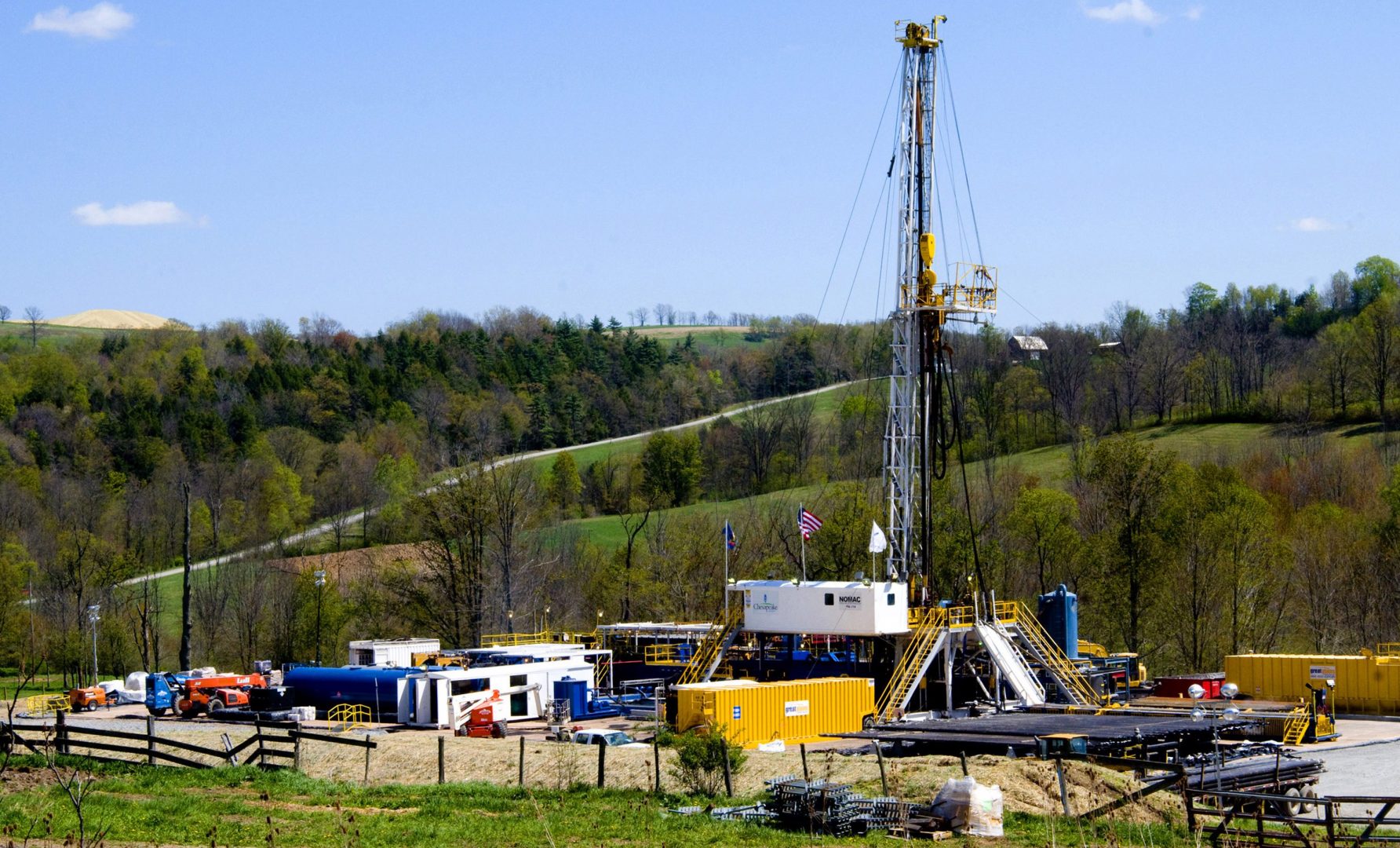
In this April 23, 2010 photo, a Chesapeake Energy natural gas well site is seen near Burlington, Pa., in Bradford County.
Ralph Wilson / AP Photo


In this April 23, 2010 photo, a Chesapeake Energy natural gas well site is seen near Burlington, Pa., in Bradford County.
Ralph Wilson / AP Photo

Ralph Wilson / AP Photo
In this April 23, 2010 photo, a Chesapeake Energy natural gas well site is seen near Burlington, Pa., in Bradford County.
A team of Harvard researchers found elevated levels of radioactivity on air particles measured downwind of fracking sites around the country.
The levels found were well below public health limits, but the authors warn they could induce “adverse health effects to residents living close” to fracking sites. The study was published this week in the journal Nature Communications.
The authors looked at 16 years worth of data from the EPA’s radiation monitoring system, from 2001 to 2017. They found increased radiation on particles 12 miles (20 km) to 31 miles (50 km) downwind of fracking sites. Those close to shallower conventional wells, meanwhile, showed virtually no increases.
The study’s lead author, Petros Koutrakis, professor of environmental sciences at the Harvard School of Public Health, said the radiation is likely coming from uranium and radon buried inside oil and gas-bearing rock formations.
“It’s a concern, but it’s not something (where) people should move out as soon as possible. I think it’s an additional risk,” Koutrakis said. “I think this is the reason we need to control these emissions.”
The authors found no evidence of a “statistically significant association” between fracking activities and an increase in radiation in the Marcellus and Utica shale region, which includes Pennsylvania. But the authors said that was probably due to a lack of monitors near gas drilling sites in the area. When they estimated how big an effect drilling would have on radiation levels there, they found the Marcellus region’s would be the biggest of all the U.S. regions studied.
“The largest effect was estimated for the (Marcellus-Utica) region,” Koutrakis said, in an email, “which is expected because of its high radon levels. However, it did not reach statistical significance most likely due to the small number of … monitoring stations in the area.”
Koutrakis said it’s unclear where in the extraction process the radiation is coming from.
“We don’t really know whether this is immediate, during the construction of the well, or during the production (process), or from the points that they use around the facilities to store wastewater,” Koutrakis said.
“We think that it is something that needs to be investigated to understand the process that produces releases of radon and to develop the engineering controls to control these emissions.”
Avner Vengosh, a professor of Earth and Ocean Sciences at Duke University, who was not involved in the study, said that while the actual levels of radiation detected were small, they warrant more investigation.
“Even though it’s a very small absolute concentration, it shows that (the radiation levels are) systematically higher than background,” Vengosh said. “This paper for me is saying there’s much more work to be done in a much more local scale to see the impact, especially where people are living.”
The Pennsylvania Department of Environmental Protection, which has studied naturally occurring radiation in shale gas activities, is reviewing the paper, spokesman Neil Shader said.
The Pennsylvania Department of Health, which is studying the health impacts of fracking, is also reviewing the paper, spokesman Nate Wardle said.
In a statement, Marcellus Shale Coalition President Dave Spigelmyer stressed that public health was “a top industry concern” and pointed to a 2016 Pennsylvania DEP study that found “little or limited potential for radiation exposure to workers or the public” from fracking operations.
Though the DEP report did find “potential for radiological environmental impacts” from spills of drilling waste, it generally found little public health risk from airborne radiation in the industry.
Koutrakis acknowledged that, as a replacement for burning coal, fracking has led to lower emissions from the power sector.
“I understand that this industry is very important to the U.S. economy and to people that have jobs in it,” he said. “So it’s important for this industry to continue in the near future. However, I think we need to understand what kind of emissions are released.”
Correction: The original version of this story misspelled Marcellus Shale Coalition President Dave Spigelmyer’s name.
StateImpact Pennsylvania is a collaboration among WITF, WHYY, and the Allegheny Front. Reporters Reid Frazier, Rachel McDevitt and Susan Phillips cover the commonwealth’s energy economy. Read their reports on this site, and hear them on public radio stations across Pennsylvania.
(listed by story count)
StateImpact Pennsylvania is a collaboration among WITF, WHYY, and the Allegheny Front. Reporters Reid Frazier, Rachel McDevitt and Susan Phillips cover the commonwealth’s energy economy. Read their reports on this site, and hear them on public radio stations across Pennsylvania.
Climate Solutions, a collaboration of news organizations, educational institutions and a theater company, uses engagement, education and storytelling to help central Pennsylvanians toward climate change literacy, resilience and adaptation. Our work will amplify how people are finding solutions to the challenges presented by a warming world.